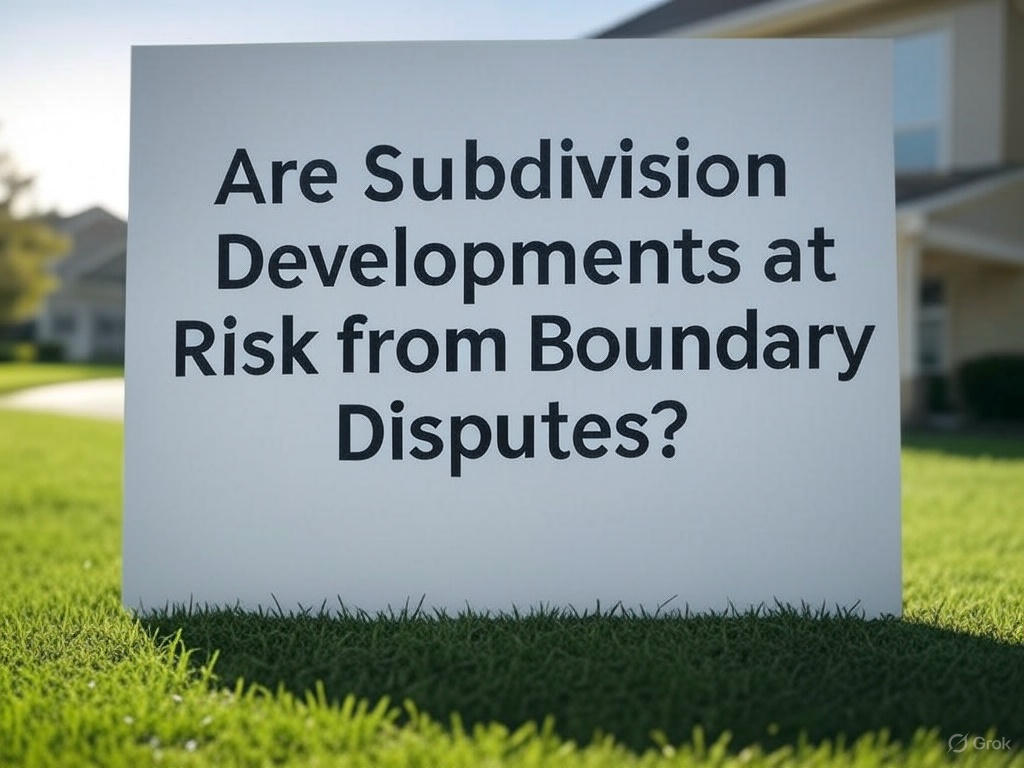Are Subdivision Developments at Risk from Boundary Disputes?

If the expansion of the suburb and creates new subdivisions in residential areas in growing markets, legal complexity, which are associated with border disputes, get greater. These problems can endanger the project schedule, increase legal costs and undermine the trust of investors-especially if the planning, surveying or the title registration is incomplete or inconsistent. The effects can go beyond individual properties and influence the viability of entire developments.
Border disputes often result from discrepancies between registered plans of the subdivision and the physical occupancy or outdated survey markers. The increasing density of sub -departments, especially those that mix free -standing houses, town houses and low condominiums, creates more error potential or overlapping claims. Developers, municipal planners and lawyers must proactively reduce these risks in order to prevent longer legal disputes and project disorders. Discover new condominiums for sale in Punta Cana via GTA-Homes and still reserve your unit today.
Legal basics of subdivision borders
In most jurisdiction, the creation of a subdivision requires a legal survey, a title registration, municipal approval and often the reconciliation of land use. Any inconsistency in these processes can lead to legal uncertainty. Even small measurement errors can be reinforced in dense projects with narrow land or a common infrastructure such as driveways or supply corridors.
Real estate lines that penetrate from neighboring land, common elements or facilities can delay closures, trigger claims for property insurance or trigger private legal disputes. Lawyers have to work closely with land vermeters and title insurers to reconcile the discrepancies before the units begin. If deviations are discovered late in the process, remedy may be necessary by municipal change or judicial correction.
Disputes between construction companies and buyers
Border problems also appear between householders and buyers. Buyers can represent incorrectly if lots of lots, fence or relief access differ from marketing plans. The builders can in turn be limited by completing construction work due to unforeseen setbacks or joint border commitments.
In order to reduce the risk of the legal dispute, developers should include detailed information on the disclosure of limits in pre -sale agreements, require independent buyer surveys and, if necessary, maintain current location plans. Legal advisors must ensure that consumer protection laws meet for sales of subdivision tests.
In some jurisdiction, the disclosure obligations extend beyond the physical limits to include expected municipal interventions or infrastructure installations. If you do not provide this information, you can trigger withdrawal rights or administrative penalties.
Municipal surveillance and title correction mechanisms
Municipalities are often asked to include the border disputes of sub -department, especially if public relief, sidewalks or care routes are involved. You may require a renewed transmission of sub -department plans, the disease of conditions for the occupancy permits or the interventions in the mediation between the parties concerned.
Legal practitioners must understand the local correction mechanisms, including the use of statutes of border adjustments, applications with minor variance or judicial declarations. Everyone has different schedules, standards of evidence and rights of appeal. For developers who work under narrow delivery plans, knowledge of these processes is of essential importance in order to avoid delays in sales or contractual breaches.
The municipal title correction programs are increasingly digitized, but require a professional advocacy group to ensure a timely solution. Lawyers should maintain active communication with local planning departments in order to pursue possible changes in the interpretation or enforcement of the correction guidelines.
Wider strategies for risk reduction for developers
Combating border disputes requires more than legal cleanup after problems occurring. Future-oriented developers now include digital mapping tools, 3D modeling and GIS-based location analysis during the phase before the construction to improve precision and limit the survey errors. In addition, the introduction of modular design standards and pre -approved municipal layouts can rationalize sub -department treatments and reduce risk exposure.
Real estate experts should also set up a central database with subdivision permits, surveyors and changes to the title for the fast cross -references in buyer inquiries or municipal checks. This improves transparency, ensures the consistency of the disclosures and improves the buyer’s trust.
Developers who work in regions with developing land use rules must be commissioned in political discussions and hearings in order to influence future names. A collaborative approach to local agencies can help to avoid surprises and open paths to more flexible dispute settlement programs.
Risk effects for long -term asset protection
In addition to transactional concerns, border disputes also have an impact on long -term protection and the resale value. Real estate that is involved in unresolved intervention or relief problems can suffer from reduced marketability, lenders or delayed closures. Title insurer can impose exceptions to future guidelines, and real estate agents often characterize such properties as additional care.
Legal advisors should encourage developers to carry out regular exams of registered plans and border certifications during phase construction. These checks can prevent questions that would otherwise only arise during the final occupancy and prevent contracts or legal claims from future buyers.
The definition of best practices for the ongoing validation and coordination of lot lines with municipal survey archives can also reduce risk exposure in the event of subdivisions with high density. These measures support the transparency of land ownership and strengthen the trust of investors in all development phases.
Last thoughts
Border disputes in new subdivision developments are not only technical nuisance – they represent material risks for developers, buyers and municipal stakeholders. Legal subjects must take on a proactive role in the administration of the title accuracy, the border clarity and the disclosure of the disclosure from the start. For those who are interested in opportunities with high growth, understanding of these legal dimensions is just as important as the assessment of market demand.





